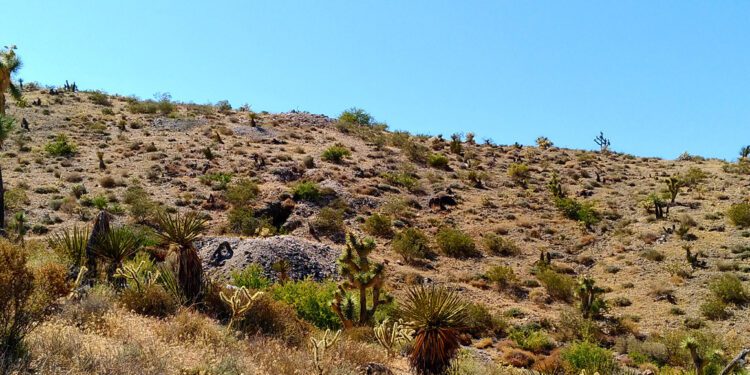CANEX Metals Inc. (TSXV:CANX) has received positive assay results for four drill holes from the company’s ongoing reverse circulation drilling program designed to expand oxide gold mineralisation at the Gold Range Project, Arizona.
Highlights
- Hole GR21-57 was a 50 metre step out to the southwest on the Excelsior zone and returned the longest continuous zone of mineralisation encountered on the Gold Range property to date, intersecting 1.0 g/t gold over 59.45 metres starting from surface including 1.4 g/t gold over 32 metres. The zone remains open for expansion.
- Hole GR21-59 from the central part of the historic Excelsior Mine returned 1.8 g/t gold over 19.8 metres, including 4.1 g/t gold over 7.6 metres, and drilling in this area has extended mineralisation 75 metres down dip where it remains open.
- Hole GR21-58 from the central part of the Excelsior zone returned 0.4 g/t gold over 33.5 metres.
- To date 30 holes of a planned 50 hole programme are complete, and drilling is expected to extend through January, 2022.
- Steady drill results are expected to be released through Q1 of 2022.
To date 30 reverse circulation drill holes have been completed at Gold Range as part of an ongoing program expected to extend through January. Currently twenty holes have been completed at the Excelsior zone and 10 have been completed at Eldorado. Drilling between the Excelsior and Eldorado zones and the testing of additional exploration targets is scheduled for January.
The Excelsior zone has now been tested over a strike length of 350 metres, over widths of 100 metres, and to depths exceeding 100 metres. Assay results for holes GR21-54, and GR21-57 to 59, all from the Excelsior zone, have been received and are presented here. A drill hole location map is shown on Figure 1, cross section D-D’ with holes GR21- 54 and 57 is shown on Figure 2 and cross section G – G’ with holes GR21-58 and 59 is shown on Figure 3.
Hole GR21-57 is a 50 metre step out on the southwest side of the Excelsior zone. The hole intersected 1.0 g/t gold over 59.45 metres starting from surface and represents the longest continuous zone of gold mineralisation encountered on the property to date with near continuous mineralization from the start to the end of the hole.
Hole GR21-57 encountered significant mineraliwation withing the footwall of the Excelsior Vein and opens up a wide zone of near surface mineralisation potentially extending further northeast.
This 59.45 metre interval includes nine isolated 1.52 metre wide samples containing only anomalous gold. If these 9 samples are excluded from the interval the zone returns 1.3 g/t gold over 45.7 metres. Hole GR21-57 also returned high grade intervals including 3.7 g/t gold over 6.1 metres and 9.5 g/t gold over 1.52 metres. This sizeable mineralised zone remains open for expansion to the east and to depth. Hole GR21-54 tested the northwest side of section D-D’ and returned anomalous gold with narrow mineralized intercepts, potentially bounding mineralization in this direction.
Holes GR21-58 and GR21-59 tested the central part of the Excelsior zone and successfully extended mineralisation over 75 metres down dip where the zone remains open. Hole GR21-59 returned high grades of 1.8 g/t gold over 19.82 metres, including 4.1 g/t gold over 7.63 metres. Hole GR21-58 returned a broad interval grading 0.4 g/t gold over 33.54 metres and suggests the mineralised zone might widen with depth in the central Excelsior area.
“The long intercepts encountered in holes GR21-57 and 58 are starting to highlight the size potential of the bulk tonnage target at Excelsior with the zone showing excellent expansion potential along the northeast trend of mineralisation,” President Dr Shane Ebert said.
“In addition to the broad envelopes of material with grades around 0.5 to 2 g/t gold, it is very encouraging that we consistently see higher grades within the core of the system, as grade can certainly be a key driver of value in these heap leach targets”.
For further information please visit: https://canexmetals.ca/












